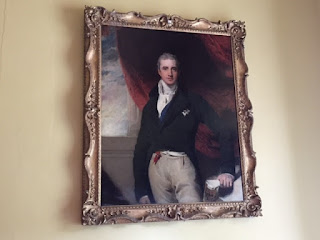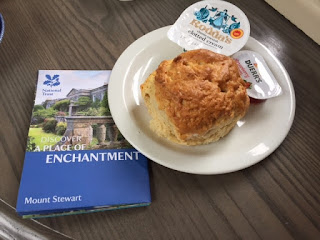I met my match at Mount Stewart in County Down. I don't mean that I found a giant scone that I couldn't eat, or that I was confronted by a posse of angry catering staff wanting vengeance for all the 0/5 marks that I've given out over the years.
I'm talking about my reading. I love it when I find a really good book about an NT property and I was over the moon to find one about Robert Stewart, aka Castlereagh, in the shop at Mount Stewart - I knew he was an interesting character. But in my excitement I failed to notice quite how weighty it was.
Here it is, with the NT handbook (and my cat's tail) for perspective:
Let's face it, scone fans; I was never going to read all of that on an Easyjet flight from Belfast to Luton. But let me share what I've learned so far:
2. Mount Stewart - the house
I can tell you now; it doesn't matter what you read about Castlereagh - nearly 200 years after he killed himself, these verses from The Masque of Anarchy will be there, giving you a fairly graphic idea of why he's none too popular in certain circles.
However, the one place you won't hear about the poem is on the guided tour at Mount Stewart - he is just referred to as "one of the greatest foreign secretaries".
So what was so bad about him? Here's some background:
So there you have it. It's probably just as well that I haven't read the Castlereagh book yet, otherwise this post would be twice as long.
Mount Stewart: 5 out of 5
Scone: 5 out of 5
Chances of me having finished my Castlereagh book by Christmas: 1 out of 5
In 2019, I went back to Northern Ireland to complete my rounds. Read more about Carrick-a-Rede, Crom, Castle Coole, Cushendun, Divis and the Black Mountain, White Park Bay, Springhill.
I'm talking about my reading. I love it when I find a really good book about an NT property and I was over the moon to find one about Robert Stewart, aka Castlereagh, in the shop at Mount Stewart - I knew he was an interesting character. But in my excitement I failed to notice quite how weighty it was.
Here it is, with the NT handbook (and my cat's tail) for perspective:
Let's face it, scone fans; I was never going to read all of that on an Easyjet flight from Belfast to Luton. But let me share what I've learned so far:
1. Mount Stewart - the history
- A man called Alexander Stewart, born in Donegal but descended from Scottish Presbyterians, married a wealthy woman called Mary Cowan in 1737 and they acquired an estate on the shore of Strangford Lough in County Down
- It was originally known as Mount Pleasant, but became Mount Stewart
- Their son, Robert, became an MP in the Irish Parliament in 1771, and although the house at Mount Stewart remained relatively simple, additional pieces were added - an ornamental building called the Temple of the Winds, lodges and driveways
- Robert's second wife was the daughter of the Earl of Camden, a mighty bigwig. This might explain how Robert was made Baron Londonderry in 1789, Viscount Castlereagh in 1795, and then Earl of Londonderry in 1796.
- His eldest son by his first wife, also Robert, styled himself Viscount Castlereagh - he's the 'interesting' Castlereagh that we're going to come to in a minute
- Work was carried out on the property to extend it over the years - after Castlereagh killed himself, his half-brother Charles made a very wealthy marriage of his own and building work took off in earnest
- Mount Stewart was a bit neglected by the fourth and fifth marquesses (Charles' sons) but the seventh marquess transformed Mount Stewart with the help of his wife, Edith - the house is presented today as they had it
- Charles and Edith left the house to their youngest daughter, Mairi, who died in 2009. Her daughter, Rose, still lives there today.
- Interesting-factoid-probably-only-interesting-to-me-and-anyone-else-in-West-London: The title of Marquess of Londonderry passed to Mairi's brother, Robin. He had three children, one of whom went on to become Annabel Goldsmith, mother of Zach Goldsmith, current MP for Richmond.
2. Mount Stewart - the house
We got there early so we joined the guided tour, which was really good. A restoration project has been going on for five years and the guide pointed some highlights:
In the Central Hall, black and white linoleum tiles that had been put down in the 1960s were removed to reveal the original 1840s floor:
On the stairs is a picture of Hambletonian, a racehorse owned by the grandfather of the fifth Marquess of Londonderry. Hambletonian took part in a two horse 'race off' in 1799 and won - this portrait shows him being rubbed down afterwards.
George Stubbs, the painter, was apparently unimpressed by how badly the horse had been treated during the race and as a result the picture has some imperfections; the horse is standing on its two left legs, for example, and the stable lad would have to have been Mr Tickle to have an arm long enough to reach the horse's back like that:
Below is the study of the seventh Marquess, who was Minister for Education in the Northern Ireland government from 1921. The guide told us how his plan for education laid out two requisites for the education of children: Catholics and Protestants should be educated together, and religion should not be included on the curriculum. His ideas were not popular and children still attend church-run schools today.
3. Castlereagh - great statesman or despicable murderer?
But let's move on to the most famous owner of Mount Stewart. There's a poem by Shelley, written in 1819 after the Peterloo massacre, and our friend Castlereagh gets a couple of verses:
In the Central Hall, black and white linoleum tiles that had been put down in the 1960s were removed to reveal the original 1840s floor:
On the stairs is a picture of Hambletonian, a racehorse owned by the grandfather of the fifth Marquess of Londonderry. Hambletonian took part in a two horse 'race off' in 1799 and won - this portrait shows him being rubbed down afterwards.
George Stubbs, the painter, was apparently unimpressed by how badly the horse had been treated during the race and as a result the picture has some imperfections; the horse is standing on its two left legs, for example, and the stable lad would have to have been Mr Tickle to have an arm long enough to reach the horse's back like that:
Below is the study of the seventh Marquess, who was Minister for Education in the Northern Ireland government from 1921. The guide told us how his plan for education laid out two requisites for the education of children: Catholics and Protestants should be educated together, and religion should not be included on the curriculum. His ideas were not popular and children still attend church-run schools today.
3. Castlereagh - great statesman or despicable murderer?
But let's move on to the most famous owner of Mount Stewart. There's a poem by Shelley, written in 1819 after the Peterloo massacre, and our friend Castlereagh gets a couple of verses:
I met Murder on the way -
He had a mask like Castlereagh -
Very smooth he looked, yet grim;
Seven blood-hounds followed him:
All were fat; and well they might
Be in admirable plight,
For one by one, and two by two,
He tossed the human hearts to chew
Which from his wide cloak he drew.
I can tell you now; it doesn't matter what you read about Castlereagh - nearly 200 years after he killed himself, these verses from The Masque of Anarchy will be there, giving you a fairly graphic idea of why he's none too popular in certain circles.
However, the one place you won't hear about the poem is on the guided tour at Mount Stewart - he is just referred to as "one of the greatest foreign secretaries".
So what was so bad about him? Here's some background:
- Castlereagh was born in Dublin into a Presbyterian family that was part of the English landed gentry
- He was considered to be a brilliant young man - his father almost bankrupted himself getting his son elected as an MP in the Dublin Parliament
- However, while some of Castlereagh's contemporaries allied themselves with the Irish Catholic populace and fought for an independent Ireland, Castlereagh went the other way and fought for an even closer union with Westminster
- He is therefore reviled in Ireland for a) his response to the Irish Rebellion in 1798 when he was Chief Secretary of Ireland and b) bringing in the Acts of Union in 1800, which saw the abolition of the Irish Parliament
- He moved to London where he held many prominent positions in government, including Secretary of State for War (1807-1809) and Foreign Secretary (1812-1822)
- His reputation as a great statesman comes largely from his contribution as the main British representative at the Congress of Vienna, which put a peace plan in place for Europe following Napoleon's defeat in 1814
- He wasn't the only one criticised for the Peterloo Massacre in 1819, when the cavalry charged into a gathering of 60,000-80,000 people in Manchester who were protesting for voting reform, killing 15 people and injuring 400-700 - the outcry was against the whole government and all of the MPs that supported the Six Acts, which banned further gatherings.
- In 1821, his father died and he became Marquess of Londonderry
- However, by 1822 it was clear that he wasn't well - his family and even the King had noticed that he seemed to be suffering from paranoia or some sort of breakdown
- On 12 August 1822 he cut his own throat and died - an inquest recorded that he was insane, allowing him to be buried in Westminster Abbey
 |
| A portrait of Castlereagh |
4. Edith, Marchioness of Londonderry
Castlereagh isn't the only well-known inhabitant of Mount Stewart. I also picked up a book about Edith Londonderry, the wife of the seventh Marquess. It's an interesting read - for 50 years, from her marriage in 1899, she was hob-nobbing with the great and the not-so-great in society (they met Hitler and various other Nazi bigwigs, which damaged their reputation) and the book details all of it. She was responsible for creating the gardens that we see today at Mount Stewart.
5. The Mount Stewart Scone
You're probably dying for a cup of tea and a scone after all that history (I know I was). And we weren't disappointed - the scone was really fresh and tasty. Top marks to Mount Stewart.
So there you have it. It's probably just as well that I haven't read the Castlereagh book yet, otherwise this post would be twice as long.
Mount Stewart: 5 out of 5
Scone: 5 out of 5
Chances of me having finished my Castlereagh book by Christmas: 1 out of 5
In 2019, I went back to Northern Ireland to complete my rounds. Read more about Carrick-a-Rede, Crom, Castle Coole, Cushendun, Divis and the Black Mountain, White Park Bay, Springhill.






No comments:
Post a Comment